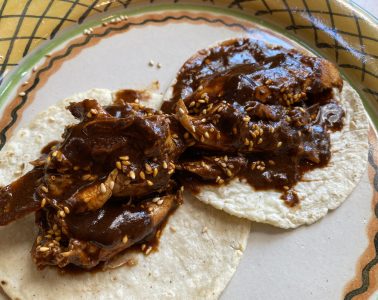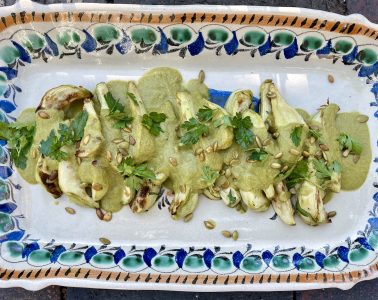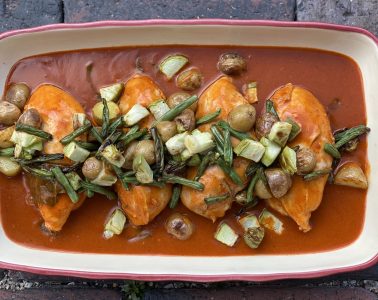INGREDIENTS
- 1/4 cup vegetable oil, olive oil or fresh-rendered lard (divided use)
- 2 medium ancho chiles, stemmed, seeded, and torn into flat pieces
- 1/2 small white onion, sliced
- 2 garlic cloves, peeled
- 2/3 of a 15-ounce can fire-roasted tomatoes
- 1 cup dry- or oil-roasted peanuts
- 2 slices firm white bread
- 2 canned chilpotle chiles en adobo
- 1/4 teaspoon allspice, preferably freshly ground
- 1/2 teaspoon cinnamon, preferably freshly ground Mexican canela
- 3 1/2 cups chicken broth (divided use)
- 1/4 cup finely chopped Mexican chocolate (for a bit sweeter mole)
- 1/2 cup red wine (for a more savory mole)
- 2 bay leaves (for a more savory mole)
- 1 tablespoon cider vinegar (for a more savory mole)
- Salt
- Sugar
INSTRUCTIONS
Heat a large, heavy deep saucepan or small Dutch oven (it’s easiest to work through all the steps in a pan that’s 8 to 10 inches wide and holds 4 to 6 quarts), over medium. Scoop in 2 tablespoons of the oil or lard. When it’s hot, add the chile pieces, onions and garlic. Cook for 7 or 8 minutes, stirring frequently, until the onion and garlic have softened and browned and the chile is toasty-looking and aromatic. Scrape it into a blender jar (setting the pan aside unwashed) and add the tomatoes, peanuts, bread, chipotle chiles, allspice, cinnamon and about 1 ½ cups of the broth to help the ingredients move through the blender blades. Blend until as smooth as you possible—that’ll take a couple of minutes with most blenders. (You will know it’s ready when a drop of the puree rubbed between my fingers doesn’t feel gritty. Unless I’ve used a powerful, high-speed blender like a VitaMix, I always pass the mixture through a medium-mesh strainer to remove chile skins or anything that didn’t get thoroughly blended.)
Return the pan to medium-high heat and add the remaining 2 tablespoons of the oil or lard. When the fat is hot enough to make a drop of the sauce sizzle fiercely, add the blended mixture all at once. Stir constantly for 7 or 8 minutes as it thickens and darkens in color—this is the critical step that fuses these disparate flavors into a single voice. When I get more than a little spattering, I lay a cookie sheet or spatter screen over most of the pot and stir from the side.
When the mixture has cooked down to a paste, stir in the broth. Partially cover the pot, let it simmer for as long as you have—½ hour is good, but an hour is better; making the mole a day ahead and refrigerating gives the best flavor.
Decide if you want your mole to tip toward sweet or savory. For a sweeter mole, add the chocolate, stirring until it is melted. For a more savory mole, stir in the red wine, bay leaves and vinegar.
No matter which direction you’ve chosen, season the mole with salt (it will take about 1 ½ teaspoons) and sugar. Adding a small amount of sugar (2 to 3 teaspoons) won’t produce a mole that’s perceptively sweet, even when added to the savory version of this sauce. What it’ll produce is a mole in which the dried chiles play their full role.
Stir in a little more broth of water to adjust the consistency to that of smooth bean soup. Turn on the oven to 350 degrees, and arrange the chicken in a 13x9-inch baking dish.
To serve the mole with chicken, ladle the hot mole over raw chicken breasts or thighs, slide it into the oven and bake until the chicken is just cooked through. Transfer the chicken to warm dinner plates, whisk the mole to insure all the chicken juices are thoroughly incorporated, then ladle it over. A sprinkling of chopped peanuts and/or a few parsley leaves are welcome garnishes.




